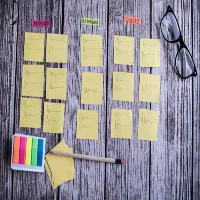Tree testing
Tree testing, also known as reverse card sorting or card-based classification testing, is a usability testing method used in UX research to evaluate the navigational structure of a website or application. In tree testing, participants are presented with a hierarchical structure of the website’s content, typically represented as a text-based outline or tree diagram.
Tree Testing:
- In tree testing, participants are presented with a pre-defined hierarchical structure of the website’s content, typically represented as a text-based outline or tree diagram.
- Participants are asked to complete specific tasks by navigating through the hierarchical structure to find the information they need.
- The focus of tree testing is on evaluating the effectiveness of the existing navigational structure in helping users locate information quickly and easily.
- Tree testing assesses the findability and usability of the navigational structure, helping identify areas for improvement in the organization and labeling of content.
- Tree testing is often used in conjunction with card sorting. In tree testing, participants are given a hierarchical menu structure (without labels) and asked to find specific items or complete tasks. This helps validate the effectiveness of the information architecture developed through card sorting.
Card Sorting
“UX card sorting” is the process of creating a user interface (UX) by organizing. Labeling information into groups on physical or digital cards. This method helps designers and researchers understand. How users categorize and prioritize information, which can inform. The layout of an extra intuitive and user-pleasant interface.
Card Sorting:
- In card sorting, participants are given a set of content items (represented as cards) and asked to group them into categories or topics that make sense to them.
- Participants can create their own categories and label them based on their understanding of the content.
- The focus of card sorting is on understanding how users mentally organize and categorize information, providing insights into the user’s mental model of the content.
- Card sorting helps inform the design of the navigational structure by identifying user-generated categories and labels that align with users’ mental models.
Types of card sorting:
Open Card Sorting:
Participants actively organize cards into groups and labels. Those groups themselves, without the researcher. Providing any predefined categories. This method provides insight into users’ natural mental models. How they perceive relationships between items.
Closed Card Sorting:
Participants are given predefined categories and asked to sort the cards into these categories. This method is useful for validating existing information architectures or navigation structures and assessing. Whether users understand and agree with the predefined categories.
Remote Card Sorting:
With the advent of online tools and remote research methodologies. Card sorting can also be conducted remotely. Participants can sort cards virtually using specialized software or online platforms. Allowing for a broader reach of participants and flexibility in research methods.
Analysis Techniques:
After the card sorting exercise, designers analyze. The results identify common patterns, groupings, and discrepancies among participants. This analysis helps inform decisions about information architecture, content organization, and navigation design.
Iterative Process:
Card sorting is often conducted iteratively throughout the design process to validate and refine. Information architectures and navigation structures. Designers may conduct multiple rounds of card sorting with different participant groups to gather diverse perspectives and insights.
Combining Methods:
Card sorting is frequently combined with other UX research methods. Such as user interviews, usability testing, and analytics analysis. To gain a comprehensive understanding of users’ needs, behaviors, and preferences.
Inclusive Design:
When conducting card sorting exercises. It’s important to include diverse participants who represent the target audience. To ensure that the resulting information architecture and navigation structure are inclusive and accessible to all users.
Real-World Applications:
Card sorting can be applied to various design challenges. Including website redesigns, and mobile app development. Content organization for intranets or knowledge bases, and product feature prioritization.
Hybrid Card Sorting:
Some researchers use a hybrid approach, combining elements of open and closed card sorting. For example, participants might be given some predefined categories. But also have the flexibility to create additional categories if needed.
Reverse Card Sorting:
In reverse card sorting, participants are given a set of categories and asked to suggest items. That belongs in each category. This approach can help validate existing categories or generate new ones based on user input.
Conclusion
In summary, while both tree testing and card sorting are usability testing methods used to evaluate the navigational structure of a website or application, tree testing focuses on evaluating the effectiveness of the existing navigational structure, while card sorting helps inform the design of the navigational structure by understanding users’ mental models of the content.
